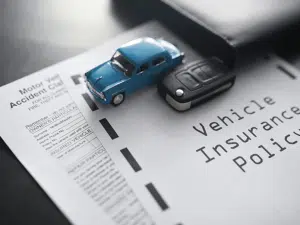02 May 9 Risk Management Tips for Commercial Fleets

Risk management is a constant concern for most commercial fleets. Claims are common and costly. That is why having a risk management plan in place can help to minimize those costs and keep your fleet on the roadways. The question many have, though, is how to make that possible. What can you do to implement a highly effective plan to minimize risk without hampering operations?
9 Essential Steps for Fleet Risk Management Success
What is risk management, and why is it so important?
 In short, managing insurance risk is a way of taking proactive steps to reduce the risk of incidents. Without any consideration of the increasing cost of liabilities and claims, consider that implementing these solutions keeps your drivers safe and secure on the road while protecting your assets.
In short, managing insurance risk is a way of taking proactive steps to reduce the risk of incidents. Without any consideration of the increasing cost of liabilities and claims, consider that implementing these solutions keeps your drivers safe and secure on the road while protecting your assets.
The right risk management strategies help you better manage your business. That helps you with reducing accidents and risks to your drivers. The result is that you’re directly managing insurance risk, lowering your cost over the long term.
How do you do this? Consider these nine strategies that work for every commercial fleet management team or owner.
#1: Establish risk management policies and procedures
Before anything else occurs, organizations must put in place effective, well-thought-out risk management policies and procedures.
Policies may include visual inspections of the vehicle, safety, and security management, and strategies for communicating problems. Put in place policies and procedures for a range of aspects of your operations, including:
Staff and human resource planning
- Services offered
- Cash flow management
- Acceptance of work
- IT solutions
- Regulatory obligations
#2: Conduct a risk assessment of your fleet to identify potential hazards
Know where you stand. To do this, you need to consider any vulnerabilities in your operations that need to be the first targeted improvement. Use the policies you’ve created to find potential hazards and risks.
- Determine what the risk is
- Find out the best mitigation strategy
- Appoint someone to handle the process
- Record findings
- Evaluate changes and updates
Complete a risk assessment early on, and then do so consistently over a period of a few months to ensure you are vigilant.
#3: Implement vehicle maintenance programs to reduce the risk of breakdowns or accidents

It works as a failsafe. In nearly all situations, trouble with braking mechanisms, worn framing, and other concerns are often evident long before the problem begins. With the use of vehicle maintenance programs, it’s highly possible to detect risks early on, eliminating them.
#4: Educate your drivers on safe driving practices and proper vehicle maintenance
A driver safety policy is a good starting point. It helps ensure everyone is on the same page in terms of what is acceptable and what is not. Putting expectations on what driver safety requirements exist on paper in a formal policy makes it hard to overlook.
Rules to include may be:
- Seat belt use
- Fatigued driving
- Distracted driving
- Adjustment of driving behaviors to fit road conditions
- Aggressive driving
- Driving under the influence
#5: Utilize telematics systems to monitor driver performance in real-time
Invest in telematics systems that incorporate the highest level of technology possible for your needs. The key here is to ensure you have a system that provides real-time insights so you can take action.
Modern systems utilize artificial intelligence and machine learning to monitor drivers from a distance, providing fleet managers with insight on the go. Noticing a tired driver is swaying allows managers to alert the driver to a needed break, significantly reducing the risk of accidents.
#6: Use risk assessment tools to identify potential risks before they occur

- Failure models and effects analysis (FMEA)
- Decision tree
- Risk matrix
- Bowtie model
The goal of these tools is to provide insight into the risk of failure, the instances of “what if” that could impact the business, and hazard operability analysis.
#7: Invest in safety equipment such as cameras, sensors, and alarms
Technology is one of the most important tools fleet managers have to improve the safety of their risk and to manage insurance risk overall. The key here is to choose the right types of tools to empower fleet management while making wise financial decisions.
Some of the most important safety equipment in today’s vehicles include:
- AI dash cams, which do not just look at the roadway but also the cabin
- Sensors that detect the risk of impact
- Implement alarms that warn of potential failures early on, so drivers have time to react in a safe manner
#8: Promote a culture of risk awareness among employees and managers
Unfortunately, even the most well-laid-out plan is going to have some limitations when it comes to implementation if your employees, managers, and drivers do not apply the risk management strategies to their daily operations. It’s up to you to promote a culture of risk awareness.
Make it clear – risk management is something you focus on to keep drivers safe
- Create a zero-tolerance for not “following the rules”
- Gamifying the process, such as offering incentives for drivers who meet objectives such as safe driver awards
- Keep communication open. Don’t tell a driver any type of safety risk that is okay to ignore.
- Invest in your people through ongoing safety training showing them the value of it.
#9: Have a Fleet Insurance Claims Services professional review and adjust your policy as needed to ensure you are adequately protected from liability risks
One of the best ways to learn about your risks is to have a professional review of them. Risk managers like this can empower your business by showing you gaps, things you cannot see because you work in the field every day.
This type of review also allows for the adjustment of your policy to ensure it fits your operations well. Too much, too little, or inappropriate coverage puts not just your insurance policy at risk but your business as a whole.
Protect Your Fleet with Comprehensive Risk Management Plan
Proper fleet risk management is ultimately essential to the operation of your business. Put in place a risk management plan now that addresses your concerns. At Fleet Response, we offer the services you need to enhance safety within your organization. That includes:
Full claims management
- Insurance services
- Maintenance management
- Subrogation management
- Safety program development and support
- Web-based solutions
- Vehicle rental services
- Accident management
At Fleet Response, we have a strong focus on providing our commercial fleet managers with the tools you need. With full solutions to meet all needs in one service, your organization stands to benefit from day one.
Fleet Response offers:
- Flexibility with customization of processes and programs to meet the specific needs of your business.
- Visibility by providing the best-in-class technology to minimize risk and maximize outcomes.
- Accountability to ensure we work to meet your individual needs.
Invest in the Services You Need to Lower Your Costs and Improve Driver Safety
What is risk management to your organization? If you do not have a plan in place or you are facing rising costs that seem out of control, it may be time to take the next step. Organizations that do not implement effective, modernized risk management strategies are at the highest risk for financial loss.
The first step is getting to know your options and your needs. Reach out to Fleet Response now to learn more about the services we can offer you to build a stronger, financially reliable business model that keeps your drivers and your business safe. Set up a consultation with us today.


 Staff and human resource planning
Staff and human resource planning Make it clear – risk management is something you focus on to keep drivers safe
Make it clear – risk management is something you focus on to keep drivers safe Full claims management
Full claims management